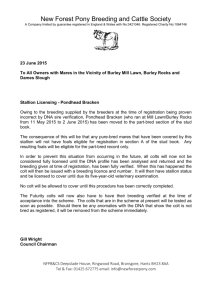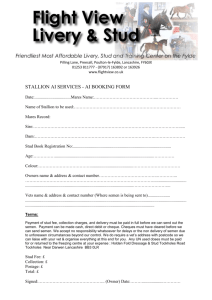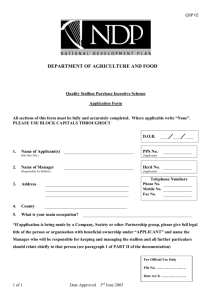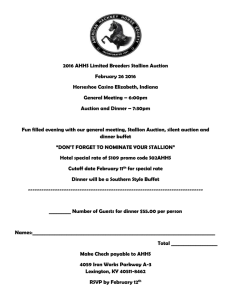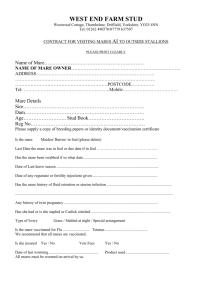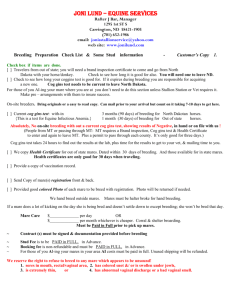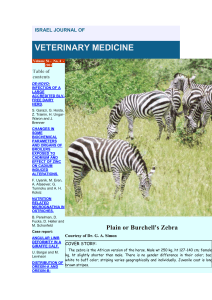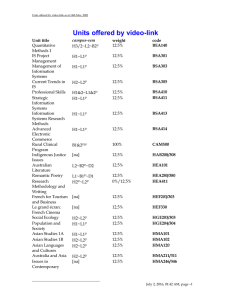LVSTK VALUATION RULES - Equine Insurance Etc.
advertisement
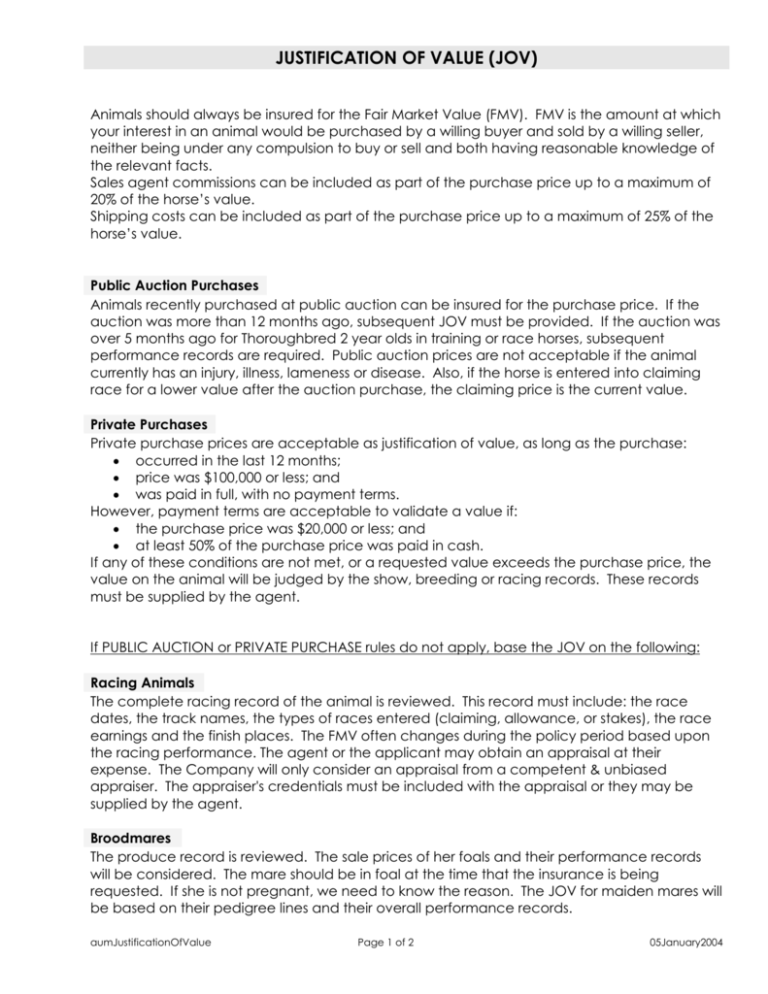
JUSTIFICATION OF VALUE (JOV) Animals should always be insured for the Fair Market Value (FMV). FMV is the amount at which your interest in an animal would be purchased by a willing buyer and sold by a willing seller, neither being under any compulsion to buy or sell and both having reasonable knowledge of the relevant facts. Sales agent commissions can be included as part of the purchase price up to a maximum of 20% of the horse’s value. Shipping costs can be included as part of the purchase price up to a maximum of 25% of the horse’s value. Public Auction Purchases Animals recently purchased at public auction can be insured for the purchase price. If the auction was more than 12 months ago, subsequent JOV must be provided. If the auction was over 5 months ago for Thoroughbred 2 year olds in training or race horses, subsequent performance records are required. Public auction prices are not acceptable if the animal currently has an injury, illness, lameness or disease. Also, if the horse is entered into claiming race for a lower value after the auction purchase, the claiming price is the current value. Private Purchases Private purchase prices are acceptable as justification of value, as long as the purchase: occurred in the last 12 months; price was $100,000 or less; and was paid in full, with no payment terms. However, payment terms are acceptable to validate a value if: the purchase price was $20,000 or less; and at least 50% of the purchase price was paid in cash. If any of these conditions are not met, or a requested value exceeds the purchase price, the value on the animal will be judged by the show, breeding or racing records. These records must be supplied by the agent. If PUBLIC AUCTION or PRIVATE PURCHASE rules do not apply, base the JOV on the following: Racing Animals The complete racing record of the animal is reviewed. This record must include: the race dates, the track names, the types of races entered (claiming, allowance, or stakes), the race earnings and the finish places. The FMV often changes during the policy period based upon the racing performance. The agent or the applicant may obtain an appraisal at their expense. The Company will only consider an appraisal from a competent & unbiased appraiser. The appraiser's credentials must be included with the appraisal or they may be supplied by the agent. Broodmares The produce record is reviewed. The sale prices of her foals and their performance records will be considered. The mare should be in foal at the time that the insurance is being requested. If she is not pregnant, we need to know the reason. The JOV for maiden mares will be based on their pedigree lines and their overall performance records. aumJustificationOfValue Page 1 of 2 05January2004 Breeding Stallions Two years of stud results are needed providing the stud fee charged and the number of nonowned mares bred. Stallions values should be in the range of 3 to 5 times their annual income. The income should only include money received from breeding to non-owned mares. Five times the annual income would be used if the stallion has been breeding to high quality mares. After age 10, the earnings calculations should be adjusted as follows: age 11- limit the value to a maximum of 4x the annual income ages 12-13 - maximum of 3x the annual income ages 14-15 - maximum of 2x the annual income age 16+ - maximum of 1x the annual income Owned mares are not considered in the above calculations. The performance and sales prices of the stallion's foals from owned and non-owned mares will help to determine the stallion's value. Also, the current market conditions will affect the stallion's value. Annual Income is the total money that was actually earned in that year for complete fulfillment of the breeding contracts. Show Horses For New Business: Obtain show records at inception. For Renewals: Obtain show records based on the following insured values: $5,000 or less - records required at ages 16, 17 and 18 every year $5,001 to $15,000 - records required every 3 years $15,001 to $25,000 - records required every 2 years $25,001 and up - records required every year For horses with: Loss of Use I, Loss of Use II, ages 16+ - show records are required every year, regardless of the value. Show records should include: the date of the show, the location of the show, the name of the show, the show rating, the class of competition, the number of horses in the class, and the placing in the class. A maximum of 50% of the annual training fees can be considered to increase a horse's value. Training fees do not include the costs of maintenance, boarding fees or veterinarian care/expenses. Annual training fees in excess of 20% of the horse’s value or annual training fees of more than $5,000 need Company approval before binding. After age 16 values should be adjusted at renewal as follows: age 17 - 20% decrease age 18 - 30% decrease Foals Insuring for 2x the stud fee is normal, especially for Thoroughbreds to be used for racing. Consideration is given for the current market conditions and the sale prices of siblings. Company approval is required for limits higher than 2x the stud fee. Yearlings Insuring for 3x the stud fee is normal, especially for Thoroughbreds to be used for racing. Consideration is given for the current market conditions and the sale prices of siblings. Company approval is required for limits higher than 3x the stud fee. aumJustificationOfValue Page 2 of 2 05January2004
